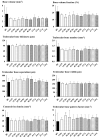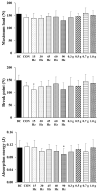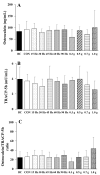Effects of whole-body vibration on bone properties in aged rats
- PMID: 34059574
- PMCID: PMC8185260
Effects of whole-body vibration on bone properties in aged rats
Abstract
Objective: This study aimed to explore optimal conditions of whole-body vibration (WBV) for improving bone properties in aged rats.
Methods: Eighty-week-old rats were divided into baseline control (BC), age-matched control (CON) and experimental groups, which underwent WBV (0.5 g) at various frequencies (15, 30, 45, 60 or 90 Hz) or WBV (45 Hz) with various magnitudes (0.3, 0.5, 0.7 or 1.0 g) for 7 weeks. After interventions, femur bone size, bone mechanical strength and circulating bone formation/resorption markers were measured, and trabecular bone microstructure (TBMS) and cortical bone geometry (CBG) of femurs were analyzed by micro-CT.
Results: Several TBMS parameters and trabecular bone mineral content were significantly lower in the 15 Hz WBV (0.5 g) group than in the CON group, suggesting damage to trabecular bone. On the other hand, although frequency/magnitude of WBV did not influence any CBG parameters, the 0.7 g and 1.0 g WBV (45 Hz) group showed an increase in tissue mineral density of cortical bone compared with the BC and CON groups, suggesting the possibility of improving cortical bone properties.
Conclusion: Based on these findings, it should be noted that WBV conditions are carefully considered when applied to elderly people.
Keywords: Aged Rats; Bone Mechanical Strength; Cortical Bone Geometry; Trabecular Bone Microstructure; Whole-Body Vibration.
Conflict of interest statement
The authors have no conflict of interest.
Figures



Similar articles
-
Effects of whole-body vibration on bone properties in type 2 diabetes model rats.Osteoporos Sarcopenia. 2024 Sep;10(3):101-107. doi: 10.1016/j.afos.2024.08.001. Epub 2024 Aug 16. Osteoporos Sarcopenia. 2024. PMID: 39403223 Free PMC article.
-
Effects of whole body vibration on bone properties in growing rats.Int Biomech. 2022 Dec;9(1):19-26. doi: 10.1080/23335432.2022.2142666. Int Biomech. 2022. PMID: 36384427 Free PMC article.
-
Prevention of bone deterioration by whole-body vibration in a rat model of pre-type 2 diabetes.J Musculoskelet Neuronal Interact. 2023 Dec 1;23(4):426-435. J Musculoskelet Neuronal Interact. 2023. PMID: 38037361 Free PMC article.
-
Possible effects of whole body vibration on bone properties in growing rats.Osteoporos Sarcopenia. 2019 Sep;5(3):78-83. doi: 10.1016/j.afos.2019.07.001. Epub 2019 Aug 7. Osteoporos Sarcopenia. 2019. PMID: 31728424 Free PMC article.
-
Whole-body vibration can attenuate the deterioration of bone mass and trabecular bone microstructure in rats with spinal cord injury.Spinal Cord. 2016 Aug;54(8):597-603. doi: 10.1038/sc.2015.220. Epub 2015 Dec 22. Spinal Cord. 2016. PMID: 26690857
References
-
- Wade SW, Strader C, Fitzpatrick LA, Anthony MS, O'Malley CD. Estimating prevalence of osteoporosis:Examples from industrialized countries. Arch Osteoporos. 2014;9:182. - PubMed
-
- Tei RMH, Ramlau-Hansen CH, Plana-Ripoll O, Brink O, Lanqdahl BL. OFELIA:Prevalence of osteoporosis fragility fracture patients. Calcif Tissue Int. 2019;104:102–114. - PubMed
-
- Hernlund E, Svedbom A, Iverqard M, Compston J, Cooper C, Stenmark J, McCloskey EV, Jonsson B, Kanis JA. Osteoporosis in the European Union:medical management, epidemiology and economic burden. A report prepared in collaboration with the International Osteoporosis Foundation (IOF) and the European Federation of Pharmaceutical Industry Associations (EFPIA) Arch Osteoporos. 2013;8:136. - PMC - PubMed
-
- Kohrt WM, Bloomfield SA, Little KD, Nelson ME, Yingling VR. American College of Sports Medicine Position Stand:physical activity and bone health. Med Sci Sports Exerc. 2004;36:1985–1996. - PubMed
MeSH terms
LinkOut - more resources
Full Text Sources
Research Materials
Miscellaneous
